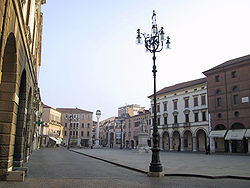Rovigo
| Rovigo | ||
|---|---|---|
| Comune | ||
| Città di Rovigo | ||

Piazza Vittorio Emanuele II.
|
||
|
||
| Location of Rovigo in Italy | ||
| Coordinates: 45°4′13″N 11°47′26″E / 45.07028°N 11.79056°E | ||
| Country | Italy | |
| Region | Veneto | |
| Province / Metropolitan city | Rovigo (RO) | |
| Frazioni | see list | |
| Government | ||
| • Mayor | Massimo Bergamin | |
| Area | ||
| • Total | 108,81 km2 (4,201 sq mi) | |
| Elevation | 7 m (23 ft) | |
| Population (31 December 2014) | ||
| • Total | 52,170 | |
| • Density | 4.8/km2 (12/sq mi) | |
| Demonym(s) | Rodigini | |
| Time zone | CET (UTC+1) | |
| • Summer (DST) | CEST (UTC+2) | |
| Postal code | 45100 | |
| Dialing code | 0425 | |
| Patron saint | St. Bellinus of Padua | |
| Saint day | November 26 | |
| Website | Official website | |
Rovigo (Italian: [rɔˈviːɡo], ![]() listen ) is a town and comune in the Veneto region of North-Eastern Italy, the capital of the eponymous province
listen ) is a town and comune in the Veneto region of North-Eastern Italy, the capital of the eponymous province
Rovigo stands on the low ground known as Polesine, 80 kilometres (50 mi) by rail southwest of Venice and 40 kilometres (25 mi) south-southwest of Padua, and on the Adigetto Canal. The comune of Rovigo extends between the rivers Adige and Canal Bianco, 40 kilometres (25 mi) west of the Adriatic Sea, except the frazione of Fenil del Turco that extends south of the Canal Bianco.
Polesine is the name of the low ground between the lower courses of the rivers Adige and Po and the sea; the derivation of the name is much discussed, generally applied only to the province of Rovigo, but is sometimes extended to the near towns of Adria and Ferrara.
Rovigo (both Rodigium and Rhodigium in Latin script) appears to be first mentioned in a document from Ravenna dating April 24, 838; the origin of the name is uncertain. In 920 it was selected as his temporary residence by the bishop of Adria, Paolo Cattaneo, after the destruction of his city by the Hungarian ravagers; the fortifications he ordered were already finished in 945. The viscounts of Rovigo built a line of brick walls in the 1130s in the name of the House of Este. The current Torre Donà is a remnant of the castle built some time in between; it is 66 m high and it may have been the highest brick tower at that time if the date of construction is correct.
...
Wikipedia


